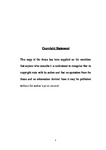Antibacterial activity of organic acids and an aqueous lime-peel extract against selected foodborne pathogens
| dc.contributor.supervisor | Beal, Jane | |
| dc.contributor.author | Al-Khanaq , Haider Naji Kazim | |
| dc.contributor.other | School of Biological and Marine Sciences | en_US |
| dc.date.accessioned | 2014-04-04T12:48:16Z | |
| dc.date.available | 2014-04-04T12:48:16Z | |
| dc.date.issued | 2014 | |
| dc.identifier | 10241355 | en_US |
| dc.identifier.uri | http://hdl.handle.net/10026.1/2971 | |
| dc.description.abstract |
Food of animal origin contaminated with food-borne pathogens still concerns the public and food experts due to its harm toward public health. Using organic acids is one of the most important interventions for controlling the microbiological safety and quality of food and has been widely used. An increase of bacterial acid resistant species gave the motivation to find an alternative way to control foodborne pathogens in meat. Limited experimental studies have investigated the antibacterial activity of organic acids and an aqueous lime-peel extract combination on chicken meat against foodborne pathogens. The inhibitory effects of citric, propionic, acetic and lactic acid in combination with an aqueous lime-peel extract (Citrus aurantifolia) against foodborne pathogens and on the organoleptic properties of chicken meat were examined. The minimum inhibitory concentration (MIC) of an aqueous lime-peel extract was investigated using spectrophotometer (TECAN) at 30°C. The MIC of an aqueous lime-peel extract with lactic, citric, acetic and propionic acids in nutrient broth individually against Salmonella Typhimurium DT104 were 2 % w/v, 8 mmol/l, 5.5 mmol/l, 5 mmol/l and 5mmol/l respectively, while against E.coli K12 were 1.5 % w/v, 7 mmol/l, 4 mmol/l, 4 mmol/l and 4mmol/l respectively at 30°C. MIC of lactic acid combined with citric or acetic or propionic acids against Salmonella Typhimurium DT104 were 8 mmol/l - 4.5 mmol/l, 7 mmol/l - 4.5 mmol/l and 7.5 mmol/l - 4 mmol/l respectively. While, against E.coli K12 the MIC of lactic acid combined with citric or acetic or propionic acids were 7 mmol/l - 3 mmol/l, and 6.5 mmol/l - 3.5 mmol/l 6 mmol/l - 3.5 mmol/l respectively. Immersion treatment (10 minutes) of lactic acid combined with acetic acid (208 mmol/l - 96 mmol/l) was used against Salmonella on chicken meat showed a negligible effect at 30°C. A combination of an aqueous lime-peel extract and acetic acid (41.6 % w/v – 1.12 mmol/l) including 1% NaCl on chicken meat was able to significantly inhibit the growth of Salmonella after 9 hours. Applying a sensory evaluation experiment revealed that treating raw chicken meat with lime added a citrusy flavour and made chicken more palatable after cooking. In spite of the induction of virulence and acid tolerance genes of salmonellae which were grow in nutrient broth (pH 2.25) after been treated with an aqueous lime-peel extract and acetic acid combination, salmonellae did not survive more than 2.5 hours at pH 2.5. This study shows that combining both organic acids and an aqueous lime-peel extract on chicken meat can inhibit the bacterial growth of Salmonella and make it more palatable than an untreated sample (control) | en_US |
| dc.description.sponsorship | Ministry of Higher Education and Scientific Research, Iraq | en_US |
| dc.language.iso | en | en_US |
| dc.publisher | Plymouth University | en_US |
| dc.title | Antibacterial activity of organic acids and an aqueous lime-peel extract against selected foodborne pathogens | en_US |
| dc.type | Masters | en_US |
| plymouth.version | Full version | en_US |
Files in this item
This item appears in the following Collection(s)
-
01 Research Theses Main Collection
Research Theses Main


